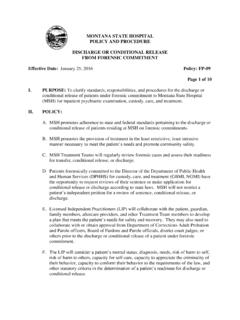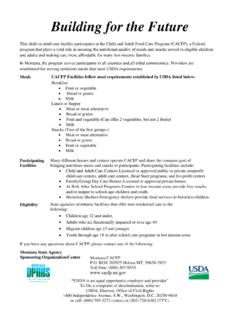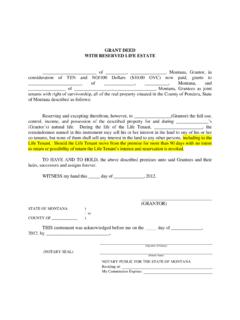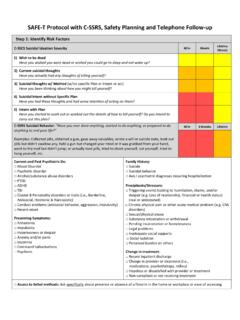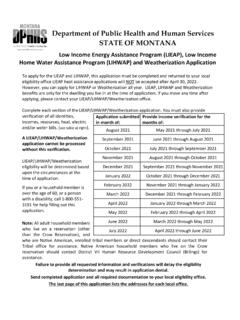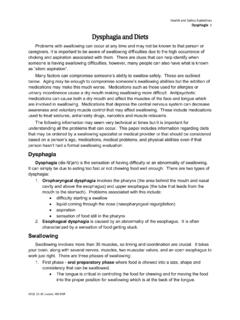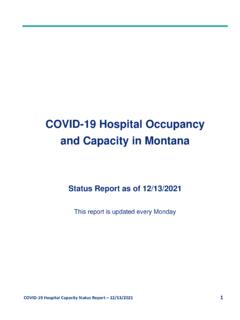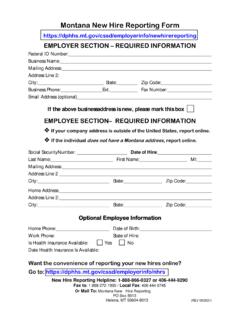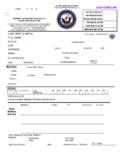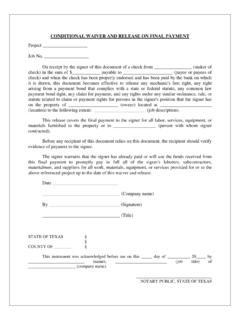Transcription of Discharge or Conditional Release from Civil Involuntary ...
1 MONTANA STATE HOSPITAL. POLICY AND PROCEDURE. Discharge OR Conditional Release FROM Civil COMMITMENT. Effective Date: October 18, 2016 Policy: AD-02. Page 1 of 7. I. PURPOSE: To clarify standards, responsibilities, and procedures for the Discharge or Conditional Release of patients under Civil Involuntary or voluntary commitment to Montana State Hospital (MSH) for inpatient psychiatric treatment. II. POLICY: A. MSH promotes adherence to state and federal standards pertaining to the Discharge or Conditional Release of patients from Civil Involuntary or voluntary commitment to the hospital.
2 B. MSH promotes the provision of treatment in the least restrictive, least intrusive manner necessary to meet the patient's needs and promote community safety. C. Licensed Independent Practitioners, in collaboration with the patient, guardian, family members, aftercare providers, and treatment team, may Discharge or conditionally Release a patient during any period of Civil Involuntary commitment. D. The Licensed Independent Practitioner will consider a patient's needs, risk of harm to self, risk of harm to others, and capacity for self-care in the determination of a patient's readiness for Discharge or Conditional Release .
3 E. The Licensed Independent Practitioner or designee, in collaboration with the patient, guardian, family members, aftercare providers, and treatment team, will develop a Discharge or Conditional Release plan designed to meet the individualized needs of the patient, promote safety, and promote recovery. F. The Social Worker will refer the patient to appropriate facilities, agencies, aftercare providers, and other appropriate resources as indicated upon Discharge or Conditional Release . G. If the patient does not have clothing suitable to the season, MSH will provide suitable clothing upon Discharge or Conditional Release .
4 H. The lack of a preferred community placement is not, in itself, a reason for continued Involuntary hospitalization of a patient who can be treated in a less restricted, Montana State Hospital Policy and Procedure Discharge OR Conditional Release FROM Civil . Page 2 of 7. COMMITMENT. community-based setting. When aftercare placements preferred by patients, guardians, or family members are not available, arrangement may be made for an alternative that adequately meets the needs of the patient. I. District courts may order the Discharge or Conditional Release of a patient on a Civil commitment, independent of the Licensed Independent Practitioner, patient, guardian, or treatment team's recommendation.
5 J. At the end of a period of Civil Involuntary commitment, if the patient's commitment is not extended by a district court, the patient must be released. If appropriate, to meet the needs of the patient, the patient may sign a voluntary commitment to the hospital. K. The MSH Director of Quality Improvement will maintain a quality assurance and performance improvement program designed to monitor the Discharge and Conditional Release system. The results of intermittent studies of quality and performance will be reported to the Hospital Administrator.
6 III. DEFINITIONS: A. Discharge The Release of a patient from inpatient treatment at MSH and unconditional termination of a period of Involuntary or voluntary Civil commitment. This Release terminates formal obligations MSH has toward the patient. B. Conditional Release The Release of a patient from inpatient treatment at MSH, which is identical to a Discharge except that the patient's Involuntary commitment is retained, responsibility for treatment is assumed by the community outpatient care provider, and the patient is subject to conditions designed to promote recovery and safety.
7 The committing court, MSH, or outpatient care provider may impose specific conditions during the period of Involuntary commitment. The conditions of Release may be extended by the court. If the patient violates the conditions of Release the court may revoke the Conditional Release and order a higher level of care, including a return to MSH. C. Pre-Placement Visit (PPV) A type of Release from MSH designed to assess a patient's readiness for Release , which may lead to a Discharge or Conditional Release . If the patient violates the conditions of the PPV the patient may be returned to the hospital without any court hearings or Involuntary Civil commitment proceedings.
8 D. Home Visit Temporary leave from MSH for purpose of a home visit to assess the potential for aftercare placement. This type of visit is not a Discharge or Conditional Release . Montana State Hospital Policy and Procedure Discharge OR Conditional Release FROM Civil . Page 3 of 7. COMMITMENT. E. Temporary Court Custody (TCC) Temporary leave from MSH for a court-ordered proceeding, which is not a Discharge or Conditional Release . However, the court may order a Conditional Release or Discharge at such a proceeding. IV. RESPONSIBILITIES: A. Licensed Independent Practitioner Direct patient care, determine Discharge and aftercare needs, assess readiness for Discharge or Conditional Release , order Discharge , order Conditional Release , order home visits, order pre-placement visits, order temporary court custody, make appropriate notifications, make appropriate warnings, and complete Discharge summaries.
9 B. Social Worker Develop Discharge or Conditional Release plans, obtain authorization for the Release of confidential information, make arrangements for appropriate aftercare services, document aftercare plans, inform patients of Discharge and aftercare plans, provide appropriate notifications, and implement Discharge and aftercare plans. C. Discharge Technician In collaboration with the social worker, verify that all Discharge or Conditional Release procedures have been completed. Administer patient satisfaction survey. V. PROCEDURE: A. Planning, Preparation, and Assessment of Readiness for Discharge or Conditional Release 1.
10 The patient's social worker will initiate a community re-entry plan within 10 days of a patient's admission. The plan must include: anticipated Discharge date;. criteria for Discharge ; staff member responsible for Discharge planning; potential aftercare providers; and referrals for financial assistance, if needed. This is a legal requirement ( 53-21-180). Refer to policy AD-04 ( Discharge and Aftercare Planning) for additional information about Discharge and aftercare planning. 2. Social workers will obtain written authorization/or implied consent to Release confidential information from the patient or guardian before communicating with others about the Discharge or Conditional Release plans, unless the disclosure or notification is required by law.
